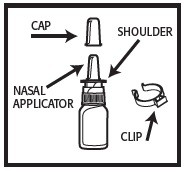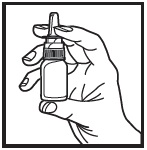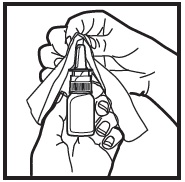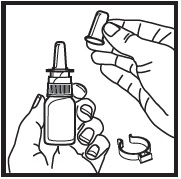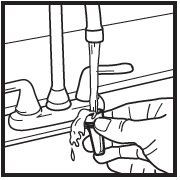olopatadine hydrochloride
safely and effectively. See full prescribing information for . Initial U.S. Approval: 1996
db024b9c-681f-4503-9fda-1eaa1add4746
HUMAN PRESCRIPTION DRUG LABEL
Aug 29, 2023
Bryant Ranch Prepack
DUNS: 171714327
Products 1
Detailed information about drug products covered under this FDA approval, including NDC codes, dosage forms, ingredients, and administration routes.
Olopatadine Hydrochloride
Product Details
FDA regulatory identification and product classification information
FDA Identifiers
Product Classification
Product Specifications
INGREDIENTS (8)
Drug Labeling Information
DESCRIPTION SECTION
11 DESCRIPTION
Olopatadine hydrochloride nasal spray, 665 mcg is a metered-spray solution for nasal administration. Olopatadine hydrochloride, the active component of olopatadine hydrochloride nasal spray, is a white, water-soluble crystalline powder. The chemical name for olopatadine hydrochloride is (Z)-11-[3-(dimethylamino)propylidene]-6,11-dihydrodibenz[b,e]oxepin-2-acetic acid hydrochloride. It has a molecular weight of 373.88 g/mol, and its molecular formula is C21H23NO3 • HCl with the following chemical structure:
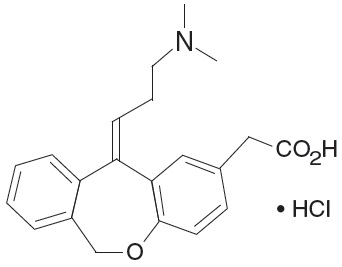
Olopatadine hydrochloride nasal spray contains 0.6% w/v olopatadine (base) in a nonsterile aqueous solution with pH of approximately 3.7. After initial priming (5 sprays), each metered spray from the nasal applicator delivers 100 µL of the aqueous solution containing 665 mcg of olopatadine hydrochloride, which is equivalent to 600 mcg of olopatadine (base) [see Dosage Forms and Strengths (3)]. Olopatadine hydrochloride nasal spray also contains benzalkonium chloride (0.01%), dibasic sodium phosphate, edetate disodium, hydrochloric acid and/or sodium hydroxide (to adjust pH), purified water and sodium chloride.
CLINICAL PHARMACOLOGY SECTION
12 CLINICAL PHARMACOLOGY
12.1 Mechanism of Action
Olopatadine is a histamine H1 receptor antagonist. The antihistaminic activity of olopatadine has been documented in isolated tissues, animal models, and humans.
12.2 Pharmacodynamics
Cardiac Electrophysiology
In a placebo-controlled cardiovascular safety study, 32 healthy volunteers received 20 mg oral solution of olopatadine twice daily for 14 days (8-fold greater daily dose than the recommended daily nasal dose). The mean QTcF (QT corrected by Fridericia’s correction method for heart rate) change from baseline was -2.7 msec and -3.8 msec for olopatadine, and placebo, respectively. In this study, 8 subjects treated with olopatadine had a QTcF change from baseline of 30-60 msec, 1 subject had a QTcF change from baseline greater than 60 msec, and no subjects had QTcF values greater than 500 msec. Eight subjects treated with placebo had a QTcF change from baseline of 30-60 msec, no subjects had a QTcF change from baseline greater than 60 msec, and no subjects had QTcF values greater than 500 msec. In a 12-month study in 429 perennial allergic rhinitis patients treated with olopatadine hydrochloride nasal spray two sprays per nostril twice daily, no evidence of any effect of olopatadine hydrochloride on QT prolongation was observed.
12.3 Pharmacokinetics
The pharmacokinetic properties of olopatadine were studied after administration by the nasal, oral, intravenous, and topical ocular routes. Olopatadine exhibited linear pharmacokinetics across the routes studied over a large dose range.
Absorption
Healthy Subjects: Olopatadine was absorbed with individual peak plasma concentrations observed between 30 minutes and 1 hour after twice daily intranasal administration of olopatadine hydrochloride nasal spray. The mean ( ± SD) steady-state peak plasma concentration (Cmax) of olopatadine was 16.0 ± 8.99 ng/mL. Systemic exposure as indexed by area under the curve (AUC0-12) averaged 66.0 ± 26.8 ng·h/mL. The average absolute bioavailability of intranasal olopatadine is 57%. The mean accumulation ratio following multiple intranasal administration of olopatadine hydrochloride nasal spray was about 1.3.
Seasonal Allergic Rhinitis Patients: Systemic exposure of olopatadine in seasonal allergic rhinitis (SAR) patients after twice daily intranasal administration of olopatadine hydrochloride nasal spray was comparable to that observed in healthy subjects. Olopatadine was absorbed with peak plasma concentrations observed between 15 minutes and 2 hours. The mean steady-state Cmax was 23.3 ± 6.2 ng/mL and AUC0-12 averaged 78.0 ± 13.9 ng·h/mL.
Distribution
The protein binding of olopatadine was moderate at approximately 55% in human serum, and independent of drug concentration over the range of 0.1 to 1000 ng/mL. Olopatadine was bound predominately to human serum albumin.
Elimination
The plasma elimination half-life of olopatadine is 8 to 12 hours. Olopatadine is mainly eliminated through urinary excretion. Approximately 70% of a [14C] olopatadine hydrochloride oral dose was recovered in urine with 17% in the feces. Of the drug-related material recovered within the first 24 hours in the urine, 86% was unchanged olopatadine with the balance comprised of olopatadine N-oxide and N-desmethyl olopatadine.
Metabolism
Olopatadine is not extensively metabolized. Based on plasma metabolite profiles following oral administration of [14C] olopatadine, at least six minor metabolites circulate in human plasma. Olopatadine accounts for 77% of peak plasma total radioactivity and all metabolites amounted to < 6% combined. Two of these have been identified as the olopatadine N-oxide and N-desmethyl olopatadine. In in vitro studies with cDNA-expressed human cytochrome P450 isoenzymes (CYP) and flavin-containing monooxygenases (FMO), N-desmethyl olopatadine (Ml) formation was catalyzed mainly by CYP3A4, while olopatadine N-oxide (M3) was primarily catalyzed by FMO1 and FMO3. Olopatadine at concentrations up to 33,900 ng/mL did not inhibit the in vitro metabolism of specific substrates for CYP1A2, CYP2C9, CYP2C19, CYP2D6, CYP2E1 and CYP3A4. The potential for olopatadine and its metabolites to act as inducers of CYP enzymes has not been evaluated.
Specific Populations
Patients with Hepatic Impairment
No specific pharmacokinetic study examining the effect of hepatic impairment was conducted. Since metabolism of olopatadine is a minor route of elimination, no adjustment of the dosing regimen of olopatadine hydrochloride nasal spray is warranted in patients with hepatic impairment.
Patients with Renal Impairment
The mean Cmax values for olopatadine following single nasal doses were not markedly different between healthy subjects (18.1 ng/mL) and patients with mild, moderate and severe renal impairment (range 15.5 to 21.6 ng/mL). The mean plasma AUC0-12 was 2-fold higher in patients with severe impairment (creatinine clearance < 30 mL/min/1.73 m2). In these patients, peak steady- state plasma concentrations of olopatadine are approximately 10-fold lower than those observed after higher 20 mg oral doses, twice daily, which were well-tolerated. These findings indicate that no adjustment of the dosing regimen of olopatadine hydrochloride nasal spray is warranted in patients with renal impairment.
Male and Female Patients
The mean systemic exposure (Cmax and AUC0-12) in female SAR patients following multiple administration of olopatadine was 40% and 27% higher, respectively than those values observed in male SAR patients.
Racial or Ethnic Groups
The effects of race on olopatadine pharmacokinetics have not been adequately investigated.
Pediatric Patients 6 to 11 Years of Age
The systemic pharmacokinetics of olopatadine, olopatadine N-oxide and N-desmethyl olopatadine in patients 6 through 11 years of age were characterized using data from 42 pediatric patients administered olopatadine hydrochloride nasal spray, one spray per nostril twice daily for a minimum of 14 days. The mean Cmax (15.4 ± 7.3 ng/mL) of olopatadine was approximately 2-fold less than was comparable to that observed in adults (78.0 ± 13.9 ng·h/mL). The Cmax and AUC0-12 of olopatadine N-oxide were comparable to that observed in adults. The Cmax and AUC0-12 of N-desmethyl olopatadine are approximately 18% and 37% higher than that observed in adults, respectively.
Pediatric Patients 2 to 5 Years of Age
The systemic pharmacokinetics of olopatadine, olopatadine N-oxide, and N-desmethyl olopatadine were characterized using population pharmacokinetic methods applied to sparse data (approximately 5 samples per patient) obtained from 66 pediatric patients (2 to less than 6 years of age) administered one- half the recommended adult dose (one spray per nostril) of olopatadine hydrochloride nasal spray twice daily for a minimum of 14 days. The mean Cmax and AUC0-12 of olopatadine were 13.4 ± 4.6 ng/mL and 75.0 ± 26.4 ng•hr/mL respectively. The mean Cmax and AUC0-12 of olopatadine N-oxide and N-desmethyl olopatadine were similar to that of patients 6 to 11 years of age.
Drug Interaction Studies
Drug interactions with inhibitors of liver enzymes are not anticipated because olopatadine is eliminated predominantly by renal excretion. Olopatadine did not inhibit the in vitro metabolism of specific substrates for CYP1A2, CYP2C9, CYP2C19, CYP2D6, CYP2E1 and CYP3A4. Based on these data, drug interactions involving P450 inhibition are not expected. Due to the modest protein binding of olopatadine (55%), drug interactions through displacement from plasma proteins are also not expected.
DOSAGE & ADMINISTRATION SECTION
2 DOSAGE AND ADMINISTRATION
2.1 Adults and Adolescents Twelve Years of Age and Older
The recommended dosage is two sprays per nostril twice daily.
2.2 Pediatric Patients Six to Eleven Years of Age
The recommended dosage is one spray per nostril twice daily.
2.3 Administration Information
Administer olopatadine hydrochloride nasal spray by the nasal route only.
Priming: Before initial use, prime olopatadine hydrochloride nasal spray by releasing 5 sprays or until a fine mist appears. The correct amount of medication cannot be assured before the initial priming.
Re-priming (as needed): When olopatadine hydrochloride nasal spray has not been used for more than 7 days, re-prime by releasing 2 sprays. Avoid spraying olopatadine hydrochloride nasal spray into the eyes.
Discard Instructions: Discard nasal device after 240 sprays (enough for 30 days of dosing) have been used even though the bottle is not completely empty. The correct amount of medication cannot be assured after 240 sprays have been used.
For nasal use only. Recommended dosages:
•
Adults and Adolescents ≥ 12 Years: Two sprays per nostril (665 mcg per spray) twice daily (2.1).
•
Pediatric Patients 6 to 11 Years: One spray per nostril (665 mcg per spray) twice daily (2.2).
•
Priming Information: Prime olopatadine hydrochloride nasal spray before initial use and when olopatadine hydrochloride nasal spray has not been used for more than 7 days (2.3).
NONCLINICAL TOXICOLOGY SECTION
13 NONCLINICAL TOXICOLOGY
13.1 Carcinogenesis, Mutagenesis, Impairment of Fertility
Carcinogenicity
Olopatadine demonstrated no tumorigenic potential in mice at oral doses up to 500 mg/kg/day (approximately 460 times the MRHDID on a mg/m2 basis) for 78 weeks or in rats at oral doses up to 200 mg/kg/day (approximately 370 times the MRHDID on a mg/m2 basis) for 104 weeks.
Mutagenesis
No mutagenic potential was observed when olopatadine was tested in an in vitro bacterial reverse mutation (Ames) test, an in vitro mammalian chromosome aberration assay or an in vivo mouse micronucleus test.
Impairment of Fertility
Olopatadine administered at an oral dose of 400 mg/kg/day, (approximately 730 times the MRHDID for adults on an mg/m2 basis) produced toxicity in male and female rats, and resulted in a decrease in the fertility index and reduced implantation rate. No effects on reproductive function were observed at 50 mg/kg/day (approximately 90 times the MRHDID on a mg/m2 basis).
INFORMATION FOR PATIENTS SECTION
17 PATIENT COUNSELING INFORMATION
Advise the patient to read the FDA-approved patient labeling (Patient Information and Instructions for Use).
Local Nasal Effects and Other Common Adverse Reactions
Inform patients that treatment with olopatadine hydrochloride nasal spray may lead to adverse reactions, which include epistaxis and nasal ulcerations [see Warnings and Precautions (5.1)]. Other common adverse reactions reported with use of olopatadine hydrochloride nasal spray include bitter taste, headache, and pharyngolaryngeal pain [see Adverse Reactions (6)].
Somnolence and Impaired Mental Alertness
Somnolence has been reported in some patients taking olopatadine hydrochloride nasal spray. Caution patients against engaging in hazardous occupations requiring complete mental alertness and motor coordination, such as driving or operating machinery after administration of olopatadine hydrochloride nasal spray [see Warnings and Precautions (5.2)].
Concurrent Use of Alcohol and Other Central Nervous System Depressants
Advise patients that concurrent use of olopatadine hydrochloride nasal spray with alcohol or other central nervous system depressants should be avoided because additional reductions in alertness and additional impairment of central nervous system performance may occur [see Warnings and Precautions (5.2)].
Keep Spray Out of Eyes
Inform patients to avoid spraying olopatadine hydrochloride nasal spray in their eyes [see Dosage and Administration (2.3)].
Made in Israel
Manufactured By Padagis
Yeruham, Israel
Distributed By
Padagis
Allegan, MI 49010 ● www.padagis.com
Rev 11-21
4S000 RC J5
SPL PATIENT PACKAGE INSERT SECTION
Patient Package Insert
|
PATIENT INFORMATION Olopatadine Hydrochloride (oh-loe-PA-ta-deen HYE-droe-KLOR-ide) Nasal spray, 665mcg/spray for intranasal use | ||
|
What is olopatadine hydrochloride nasal spray? Olopatadine hydrochloride nasal spray is a prescription nasal spray that contains an antihistamine. Olopatadine hydrochloride nasal spray is used to treat seasonal allergy symptoms in adults and children 6 years of age and older. It is not known if olopatadine hydrochloride nasal spray is safe and effective in children under 6 years of age. | ||
|
Before using olopatadine hydrochloride nasal spray, tell your healthcare provider about all of your medical conditions, including if you: • • • Tell your healthcare provider about all the medicines you take, including prescription and over-the-counter medicines, vitamins, and herbal supplements. Olopatadine hydrochloride nasal spray and other medicines may affect each other and cause side effects. Know the medicines you take. Keep a list of your medicines and show it to your healthcare provider or pharmacist when you get a new medicine. | ||
|
How should I use olopatadine hydrochloride nasal spray? • • • • • • | ||
|
What should I avoid while using olopatadine hydrochloride nasal spray? • Do not drive, operate machinery, or do anything that needs you to be alert until you know how olopatadine hydrochloride nasal spray affects you. • | ||
|
What are the possible side effects of olopatadine hydrochloride nasal spray? Olopatadine hydrochloride nasal spray may cause serious side effects, including: • • • • The most common side effects of olopatadine hydrochloride nasal spray in people 12 years of age and older include: | ||
|
• • |
• • |
• • |
|
The most common side effects of olopatadine hydrochloride nasal spray in people 6 to 11 years of age include: | ||
|
• • |
• • |
• |
|
Tell your healthcare provider if you have any side effect that bothers you or that does not go away. These are not all of the possible side effects of olopatadine hydrochloride nasal spray. For more information, ask your healthcare provider or pharmacist. Call your doctor for medical advice about side effects. You may report side effects to FDA at 1-800-FDA-1088. | ||
|
How should I store olopatadine hydrochloride nasal spray? • • Keep olopatadine hydrochloride nasal spray and all medicines out of the reach of children. | ||
|
General information about olopatadine hydrochloride nasal spray. Medicines are sometimes prescribed for conditions that are not mentioned in the Patient Information leaflet. Do not use olopatadine hydrochloride nasal spray for a condition for which it was not prescribed. Do not give olopatadine hydrochloride nasal spray to other people, even if they have the same symptoms you have. It may harm them. You can ask your healthcare provider or pharmacist for information about olopatadine hydrochloride nasal spray that is written for health professionals. | ||
|
What are the ingredients in olopatadine hydrochloride nasal spray? Active ingredient: olopatadine hydrochloride 665 micrograms per spray. Inactive ingredients: 0.01% benzalkonium chloride, dibasic sodium phosphate, edetate disodium, hydrochloric acid and/or sodium hydroxide, purified water and sodium chloride. Made in Israel Manufactured By Padagis Yeruham, Israel Distributed By Padagis Allegan, MI 49010 For more information, go to www.padagis.com or call 1-866-634-9120. 4S000 RC J5 |
This Patient Information has been approved by the U.S. Food and Drug Administration. Revised: 11/2021
INSTRUCTIONS FOR USE SECTION
Instructions for Use
|
INSTRUCTIONS FOR USE Olopatadine Hydrochloride (oh-loe-PA-ta-deen HYE-droe-KLOR-ide) Nasal spray, 665mcg/spray for intranasal use | |
|
This Instructions for Use contains information on how to use olopatadine hydrochloride nasal spray. Read this Instructions for Use that comes with olopatadine hydrochloride nasal spray before you start using it and each time you get a refill. There may be new information. This information does not take the place of talking with your healthcare provider about your medical condition or treatment. Olopatadine hydrochloride nasal spray is for use in your nose only. Do not spray olopatadine hydrochloride nasal spray in your eyes or mouth. Important information you need to know before using olopatadine hydrochloride nasal spray • • • | |
|
Using olopatadine hydrochloride nasal spray | |
|
Step 1. Remove the blue plastic cap and the blue clip (seeFigure A). |
Figure A |
|
**Step 2.**Hold the bottle and press down on the shoulders of the nasal applicator with your forefinger and middle finger. • • • |
Figure B |
|
Step 3. Gently blow your nose to clear your nostrils. Hold 1 nostril closed with a finger. Tilt your head down (chin toward chest) and insert the nasal applicator into a nostril. Hold the bottle upright with the nasal applicator tip pointing away from the center of the nose (seeFigure C). Step 4. Breathe in gently through your nose. While breathing in, press firmly and quickly on the nasal applicator shoulders to release the spray into your nostril (seeFigure C). Step 5. Breathe out through your mouth.Do not tilt your head back or blow your nose right after using olopatadine hydrochloride nasal spray. This may cause you to get a bitter taste in your mouth. Step 6. Repeat Steps3 through 5 above to deliver a spray in your other nostril. Step 7. If your healthcare provider tells you to use 2 sprays in each nostril, repeatSteps 3 through 5 for the second spray in each nostril. |
Figure C |
|
Step 8. Wipe the nasal applicator with a clean tissue and replace the plastic cap and clip (seeFigure D). |
Figure D |
|
Cleaning the olopatadine hydrochloride nasal spray nasal applicator | |
|
Step 9. To clean the nasal applicator, remove the plastic cap and clip (seeFigure E). If the nasal applicator becomes clogged,do not try to clear it using a pointed object. |
Figure E |
|
Step 10. Gently pull the nasal applicator up to remove it from the bottle (seeFigure F). |
Figure F |
|
Step 11. With the nasal applicator pointing downwards, wash it by running warm tap water into the nasal applicator for about 1 minute (seeFigure G). Step 12. Shake the nasal applicator to remove any water and put the nasal applicator back on the bottle. Step 13. Prime the bottle again by pressing the shoulders of the bottle down firmly and releasing the shoulders 2 times or until you see a fine mist come out of the white nasal applicator. RepeatSteps 11 and 12 above if the nasal applicator is still clogged. |
Figure G |
|
How should I store olopatadine hydrochloride nasal spray? • • Keep olopatadine hydrochloride nasal spray and all medicines out of the reach of children. Made in Israel Manufactured By Padagis, Yeruham, Israel Distributed By Padagis, Allegan, MI 49010 |
This Instructions for Use has been approved by the U.S. Food and Drug Administration. Revised: 11/2021

